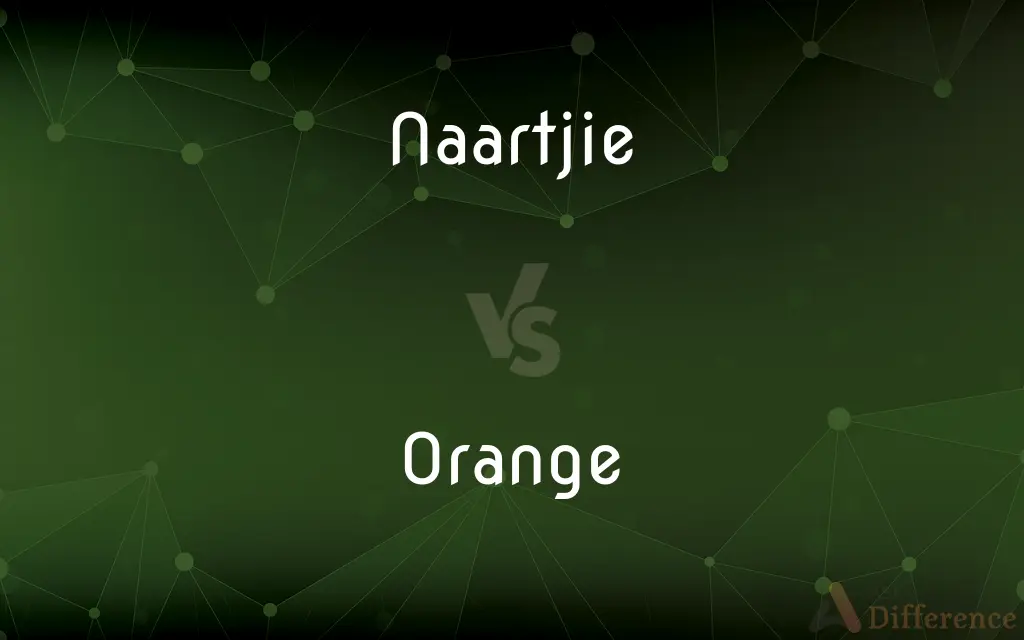Naartjie vs. Orange — What's the Difference?
Edited by Tayyaba Rehman — By Urooj Arif — Updated on April 19, 2024
Naartjie is a small, sweet citrus fruit with a loose, easy-to-peel skin, whereas an orange is larger, slightly less sweet, and has a firmer, more difficult-to-peel skin.

Difference Between Naartjie and Orange
Table of Contents
ADVERTISEMENT
Key Differences
Naartjie, a type of mandarin orange, is known for its distinctively soft and easily peelable skin, making it a popular choice for quick snacks. On the other hand, the common orange typically has a thicker, more robust skin that often requires the use of a knife or a considerable effort with the fingers to peel.
The flavor of a naartjie is sweet with a hint of tartness, which makes it highly appealing to both children and adults. Whereas, oranges can vary more widely in flavor, ranging from sweet to quite tart, depending on the variety and growing conditions.
Naartjies are smaller in size and often have a more flattened shape compared to the rounder, larger oranges. This size difference makes naartjies more convenient for individual consumption.
In terms of segment separation, naartjies tend to have looser segments that are easier to separate and consume. Oranges, however, often have tightly packed segments that may need more effort to pull apart.
When it comes to nutritional content, both naartjies and oranges are rich in vitamin C, fiber, and other nutrients, but naartjies typically have slightly higher levels of vitamin C per serving compared to oranges.
ADVERTISEMENT
Comparison Chart
Size
Smaller, more compact
Larger and rounder
Peel
Soft, easy to peel
Thicker, harder to peel
Flavor
Sweet with mild tartness
Ranges from sweet to tart
Segments
Looser, easy to separate
Tightly packed, harder to separate
Nutritional content
Slightly higher vitamin C
Slightly lower vitamin C
Compare with Definitions
Naartjie
A type of mandarin orange known for its sweetness.
The naartjie tasted so sweet that no additional sugar was needed.
Orange
Comes in varieties such as Valencia and navel.
I prefer navel oranges because they are seedless.
Naartjie
A small citrus fruit with a loose, easy-to-peel skin.
I packed a naartjie in my lunch for a quick and healthy snack.
Orange
A round citrus fruit known for its vitamin C content.
I squeezed a fresh orange to make some immune-boosting juice.
Naartjie
Often used in desserts and salads for its distinct flavor.
The dessert featured naartjie segments topped with a sprinkle of cinnamon.
Orange
Cultivated in numerous countries around the world.
Florida oranges are famous for their juiciness.
Naartjie
Grown primarily in warmer climates.
The naartjie tree in our backyard thrives in the mild winter.
Orange
Used extensively in both cooking and beverages.
She added orange zest to the cake batter for a citrusy flavor.
Naartjie
Popular among children because of its manageable size and sweet taste.
The kids eagerly grabbed naartjies from the fruit bowl.
Orange
A staple fruit in many diets globally.
Oranges are a common snack after meals in many cultures.
Naartjie
(South Africa) Citrus reticulata (mandarin, satsuma, tangerine); a soft, loose-skinned tangerine.
Orange
A town in southern France, on the River Rhône, home of the ancestors of the Dutch royal house.
Orange
Relating to the Orange Order
Orange marches
Orange
Any of several evergreen trees of the genus Citrus of Southeast Asia, widely cultivated in warm regions and having fragrant white flowers and round fruit with a yellowish or reddish rind and a sectioned, pulpy interior, especially the sweet orange and the bitter orange.
Orange
The fruit of any of these trees, having a sweetish, acidic juice.
Orange
Any of several similar plants, such as the Osage orange and the mock orange.
Orange
The hue of that portion of the visible spectrum lying between red and yellow, evoked in the human observer by radiant energy with wavelengths of approximately 590 to 630 nanometers; any of a group of colors between red and yellow in hue, of medium lightness and moderate saturation.
Orange
Of the color orange.
Orange
Made from oranges.
Orange
Tasting or smelling like oranges.
Orange
(countable) An evergreen tree of the genus Citrus such as Citrus sinensis.
Orange
(countable) The fruit of the orange tree; a citrus fruit with a slightly sour flavour.
Orange
The colour of a ripe fruit of an orange tree, midway between red and yellow.
Orange
Various drinks:
Orange
(uncountable) Orange juice.
Orange
(uncountable) An orange-coloured and orange-flavoured cordial.
Orange
(uncountable) An orange-coloured and orange-flavoured soft drink.
Orange
Having the colour of the fruit of an orange tree; yellowred; reddish-yellow.
Orange
(transitive) To color orange.
Orange
(intransitive) To become orange.
Orange
The fruit of a tree of the genus Citrus (Citrus Aurantium). It is usually round, and consists of pulpy carpels, commonly ten in number, inclosed in a leathery rind, which is easily separable, and is reddish yellow when ripe.
Orange
The tree that bears oranges; the orange tree.
Orange
The color of an orange; reddish yellow.
Orange
Of or pertaining to an orange; of the color of an orange; reddish yellow; as, an orange ribbon.
Orange
Round yellow to orange fruit of any of several citrus trees
Orange
Any of a range of colors between red and yellow
Orange
Any citrus tree bearing oranges
Orange
Any pigment producing the orange color
Orange
A river in South Africa that flows generally westward to the Atlantic Ocean
Orange
Similar to the color of a ripe orange
Common Curiosities
How do you peel a naartjie?
You can usually peel a naartjie by hand without the need for any tools, thanks to its loose skin.
Which has more sugar, a naartjie or an orange?
Naartjies generally have a slightly higher sugar content than oranges, making them sweeter.
What is a naartjie?
A naartjie is a small, sweet citrus fruit known for its easy-to-peel skin, often considered a type of mandarin.
Why are naartjies considered easy to eat?
Due to their small size and easily separable segments, naartjies are considered convenient and kid-friendly.
What are the health benefits of eating an orange?
Oranges are high in vitamin C, fiber, and antioxidants, which are beneficial for immune support and overall health.
What makes naartjies unique compared to other citrus fruits?
Their easy-to-peel skin and sweet, slightly tart flavor make naartjies unique among citrus fruits.
What is the best way to store oranges?
Oranges are best stored in a cool, dry place away from direct sunlight or in the refrigerator to extend their shelf life.
How long do naartjies last after purchase?
Naartjies last about a week when stored properly in a cool, dry place.
Can I grow an orange tree at home?
Yes, you can grow an orange tree at home if you have a suitable climate or indoor environment.
Can naartjies be substituted for oranges in recipes?
Yes, naartjies can be substituted for oranges in most recipes, though they might add a slightly sweeter and less tart flavor.
What is the best season for buying fresh oranges?
The best season for buying fresh oranges is usually from late fall through winter.
Are naartjies good for you?
Yes, naartjies are nutritious, offering vitamin C, fiber, and various antioxidants.
What dishes are improved by adding oranges?
Oranges enhance many dishes, from salads and desserts to marinades and beverages.
Are there seedless varieties of naartjies?
Yes, there are seedless varieties of naartjies, which are especially popular for snacking.
How do naartjies compare in price to oranges?
Naartjies can be slightly more expensive than oranges, depending on availability and season.
Share Your Discovery

Previous Comparison
Dual vs. Duet
Next Comparison
Transelementation vs. TransubstantiationAuthor Spotlight
Written by
Urooj ArifUrooj is a skilled content writer at Ask Difference, known for her exceptional ability to simplify complex topics into engaging and informative content. With a passion for research and a flair for clear, concise writing, she consistently delivers articles that resonate with our diverse audience.
Edited by
Tayyaba RehmanTayyaba Rehman is a distinguished writer, currently serving as a primary contributor to askdifference.com. As a researcher in semantics and etymology, Tayyaba's passion for the complexity of languages and their distinctions has found a perfect home on the platform. Tayyaba delves into the intricacies of language, distinguishing between commonly confused words and phrases, thereby providing clarity for readers worldwide.














































